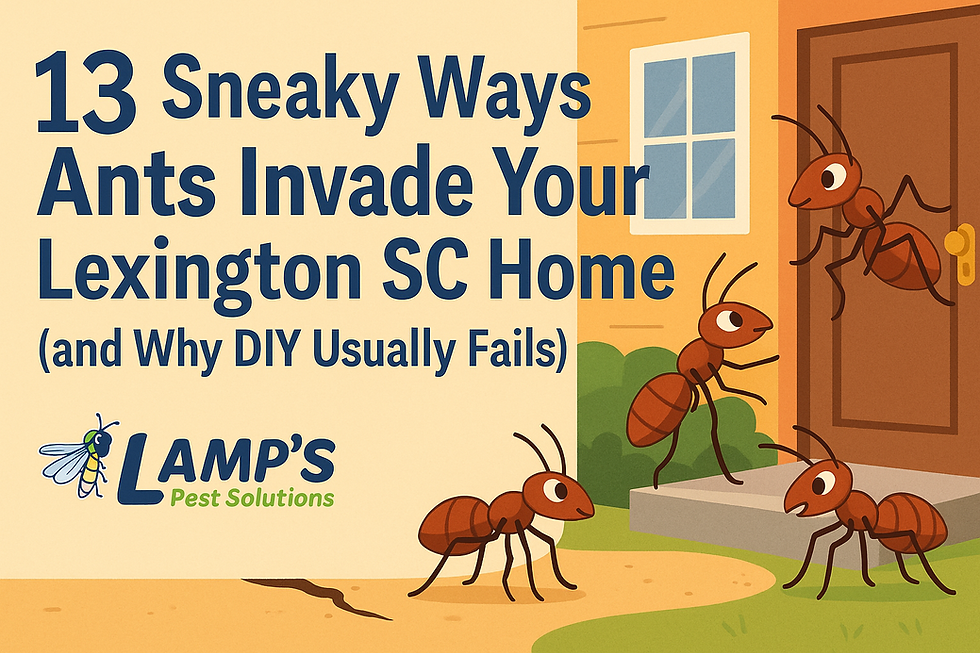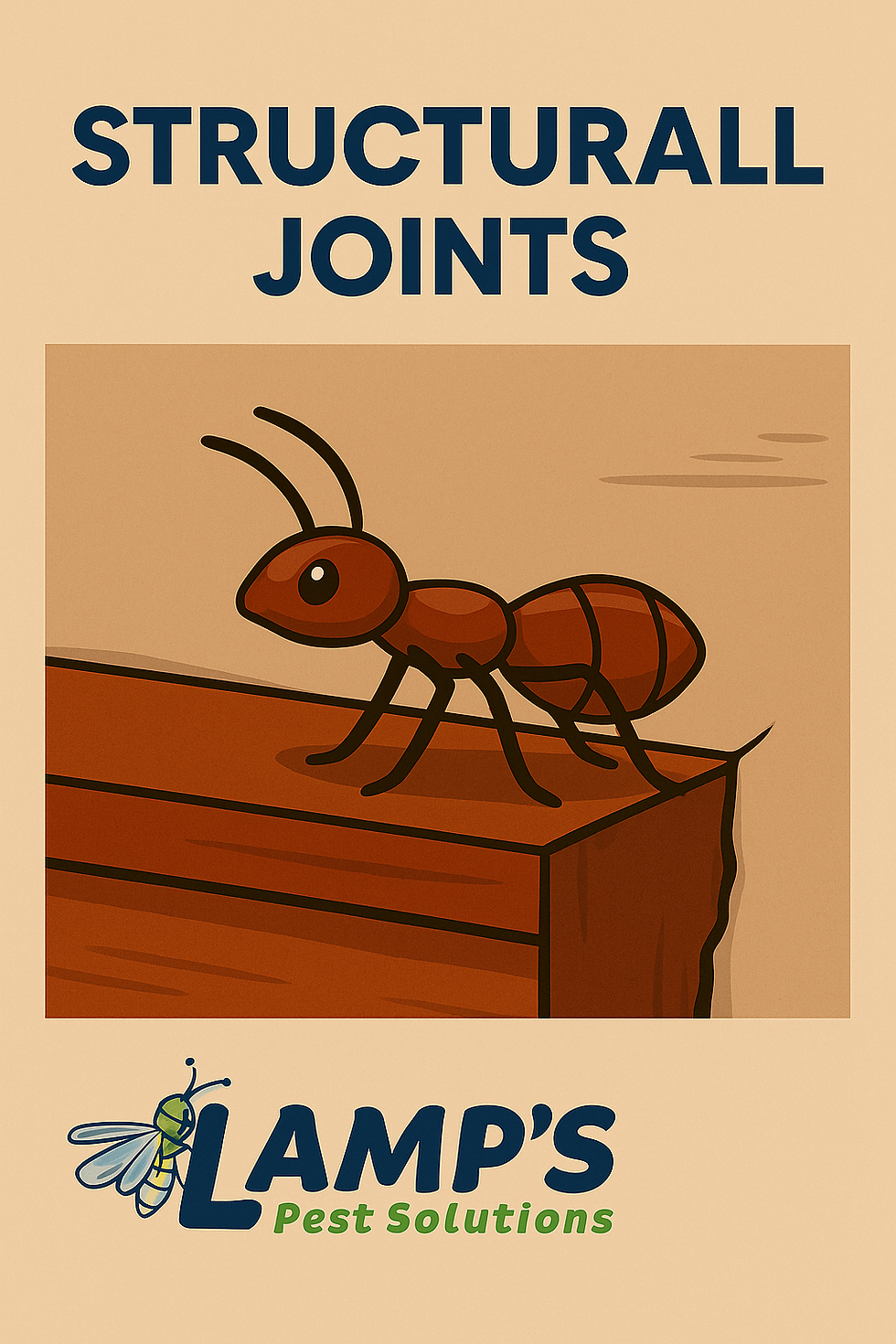13 Sneaky Ways Ants Invade Your Lexington SC Home (and Why DIY Usually Fails)
- rick59539
- Aug 4
- 6 min read

Ants Don’t Need a Key
Ants don’t pay rent, but they sure act like they own the place. Here in Lexington, South Carolina — from the shores of Lake Murray to the tree-lined neighborhoods of Gilbert and Red Bank — ants are constantly looking for creative ways to move in. They don’t knock, they don’t call ahead — they just show up in your kitchen, bathroom, or garage like they were invited.
If you’ve ever wondered, “How on earth are these ants getting inside?”, the answer might surprise you. They have more entry strategies than a teenager trying to sneak past curfew. Today, we’re revealing 13 of the most common ways ants invade local homes — along with real-life style stories, practical prevention tips, and why DIY fixes often just don’t cut it.

1. Cracks and Crevices
Ants can exploit even the smallest flaws in your home’s defenses. A gap as small as 1 millimeter is like a front door to them. They squeeze in through cracks in walls, foundations, or baseboards, often completely unnoticed until the infestation is in full swing.
Local Story: Last month in Gilbert, we visited a home where ants had been sneaking in through a nearly invisible gap near the kitchen floor molding. The homeowners thought the problem was “seasonal,” but the ants had actually been running a 24/7 snack service from the yard to the pantry for months.
Prevention Tips:
Seal gaps with high-quality caulk designed for exterior use.
Inspect baseboards, trim, and siding at least twice a year.
Remember: even the best seal won’t matter if the colony is thriving outside — professional elimination is key.

2. Door and Window Frames
Unsealed or poorly sealed frames around doors and windows are like open invitations for ants. Without tight screens or proper weather stripping, they have a straight shot inside.
Local Story: A Red Bank homeowner called us after “mystery ants” kept showing up in the bathroom. We found a loose section of weather stripping on a side door — the ants had a direct hallway from the yard to the bathmat.
Prevention Tips:
Replace weather stripping annually or when it shows wear.
Install door sweeps for exterior doors.
Check window screens for small tears — ants can fit through holes you might ignore.
3. Utility Openings

Where plumbing, electrical lines, or cables enter your home, ants see opportunity. These gaps provide warmth, moisture, and a hidden path inside.
Local Story: In Batesburg-Leesville, we found ants following the warm air from a dryer vent right into the laundry room. The scent trail was so strong that we could follow it backwards to the nest without losing it.
Prevention Tips:
Use expanding foam or pest-resistant sealant around utility lines.
Check for deterioration around pipes under sinks and behind appliances.
Keep in mind that some ants can chew through softer sealants — ongoing inspection is important.

4. Vents and Ducts
Unscreened or damaged vents are open doors for pests, including ants. Dryer vents, bathroom exhausts, and even HVAC intakes can serve as entryways.
Local Story: A Lexington homeowner discovered ants in their upstairs bathroom. The culprit? An unscreened roof vent with an ant trail marching in.
Prevention Tips:
Install fine-mesh screens over all vents.
Check dryer vent flaps to ensure they close fully.
Keep vegetation and mulch away from vent openings.

5. Vegetation Bridges
Tree branches, shrubs, or vines touching your home act like natural ant highways. Ants can bypass ground treatments and head straight for your siding or roof.
Local Story: We treated a home near Lake Murray where ants were coming in through a second-story window — via an oak branch brushing against the siding. The homeowner had no idea the branch was their ant problem.
Prevention Tips:
Keep all vegetation at least two feet from your home.
Regularly prune trees and shrubs, especially near rooflines.
Avoid ivy or climbing vines on exterior walls.

6. Structural Joints
Expansion joints and points where building materials meet (brick and wood, siding and trim) create perfect access points for ants.
Local Story: In Gilbert, carpenter ants were entering through the joint where brick met wood siding, tunneling in so quietly the homeowner only noticed when they saw frass (wood shavings).
Prevention Tips:
Seal joints with flexible, pest-resistant materials.
Inspect annually, especially after storms or extreme weather.
Pay attention to any sawdust-like debris near walls — it’s a red flag for carpenter ants.
7. Siding Gaps
Small spaces between siding panels or where siding meets other materials allow ants to slip through unnoticed.
Local Story: A Lexington family kept finding ants in the playroom. We traced the trail back to a tiny gap behind the siding near a toy bin. Once inside, they had access to the whole wall void.

Prevention Tips:
Inspect siding after storms for lifted or warped panels.
Use backer rod and sealant for larger gaps.
Avoid storing food or sugary items along exterior walls.
8. Chimney Openings

An uncapped chimney isn’t just for Santa — ants can use it too, especially if they’re nesting in nearby trees.
Local Story: In Red Bank, we found a carpenter ant colony nesting in the attic after entering through a gap in the chimney flashing. They’d made a comfortable home in the insulation.
Prevention Tips:
Install a chimney cap with fine mesh.
Seal flashing with weatherproof materials.
Keep tree branches well clear of the chimney area.
9. Garage Entries

Gaps under garage doors are an ant superhighway. They often go unnoticed until ants show up in storage areas or cars.
Local Story: A West Columbia garage had a visible ant trail leading from a flowerbed right under the garage door — straight to a pet food container.
Prevention Tips:
Replace worn or damaged weather stripping under garage doors.
Avoid storing pet food or bird seed directly on the floor.
Sweep and clean garage floors regularly to remove crumbs and debris.
10. Crawlspaces and Basements

Ants love the cool, damp environment of a crawlspace or basement, and it’s often a launching point for infestations upstairs.
Local Story: In Batesburg-Leesville, an unsealed crawlspace vent led to an infestation in the kitchen above. The ants had full access to plumbing lines and subfloor spaces.
Prevention Tips:
Seal crawlspace vents with pest-proof covers.
Address moisture problems with proper drainage and vapor barriers.
Schedule annual crawlspace inspections.

11. Mail Slots or Pet Doors
If it’s open, ants will use it. Loose pet door flaps and open mail slots are easy targets.
Local Story: We treated a Lexington home where ants used a loose pet door flap to get into the mudroom. They went straight for the dog’s food bowl.
Prevention Tips:
Check pet doors for tight seals.
Avoid leaving pet food out overnight.
Use ant-proof pet bowls if you’ve had past issues.
12. Cracks in Concrete Slabs
Even concrete isn’t ant-proof. Pavement ants in particular thrive here.
Local Story: In Gilbert, pavement ants were entering through hairline cracks in a basement floor. They’d built tunnels underneath and simply popped up inside.
Prevention Tips:
Seal cracks with concrete filler or epoxy.
Keep the perimeter of your home clear of debris.
Treat both inside and outside to fully control pavement ant colonies.
13. Roof Vents and Soffits
Damaged soffits or vents allow ants to enter attics and upper levels.
Local Story: A Batesburg-Leesville homeowner found ants in holiday decorations stored in the attic. They’d entered through a damaged soffit vent.
Prevention Tips:
Inspect soffits and vents annually.
Use fine mesh to keep pests out while allowing airflow.
Store seasonal items in sealed bins.
Why Ant Problems in Lexington Are Worse
Our warm, humid climate and sandy soil are paradise for ants. After heavy rains, ants head indoors to escape flooding, while summer droughts push them inside for water. Argentine ants, carpenter ants, pavement ants, and fire ants all thrive here — and each has its own favorite entry points.
Why DIY Fails Long-Term
Store sprays kill the ants you see but often miss the queen and the rest of the colony. Some treatments cause colonies to split, creating multiple infestations. Without professional-grade products and methods, ants will return — often in greater numbers.
How Lamp’s Pest Solutions Solves It
Full inspection to locate all entry points.
Targeted treatment to eliminate colonies at the source.
Sealing and prevention to keep them out for good.
Free consultation, often same-day service, and a friendly local team that knows Lexington SC pests inside and out.
FAQ
Q: What is the most common way ants get into homes in South Carolina?
A: Tiny cracks and gaps around doors, windows, and foundations.
Q: Do ants come inside more after rain?
A: Yes. Flooded nests push ants indoors.
Q: Will killing ants inside solve the problem?
A: No. The colony must be eliminated.
Q: Are Argentine ants common in Lexington SC?
A: Yes, and they can form massive colonies.
Q: How can I prevent ants from returning?
A: Seal entry points, store food tightly, and get regular professional service.
Q: Can ants damage my home?
A: Carpenter ants can weaken wood structures over time.
Q: Why do I see ants in winter?
A: Some colonies move indoors for warmth and food.
Q: Do certain plants attract ants?
A: Yes — flowering plants and fruit trees can draw them closer to your home.
About Lamp’s Pest Solutions
Lamp’s Pest Solutions is a locally owned pest control company in Lexington, SC, serving Lexington, Gilbert, Red Bank, Batesburg-Leesville, West Columbia, and surrounding areas. We specialize in fast, friendly, and effective solutions for ants, roaches, stinging insects, rodents, and more. Call us today at
for a free consultation — often with same-day service available.



Comments